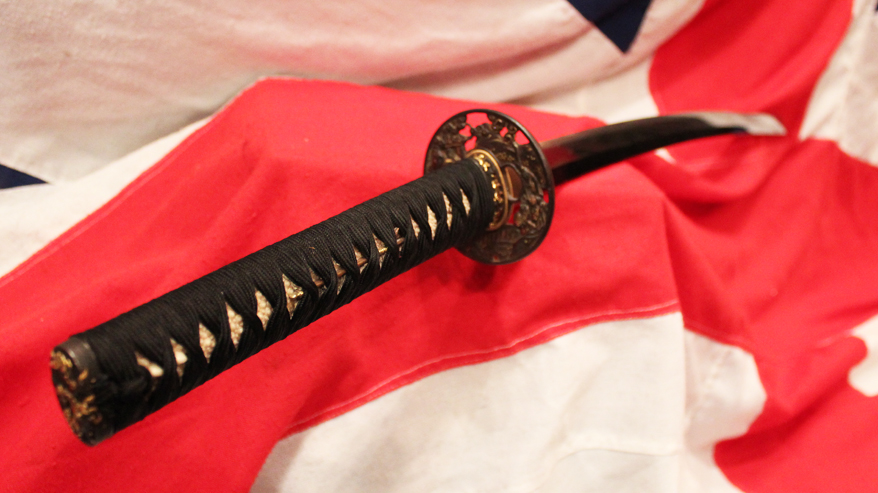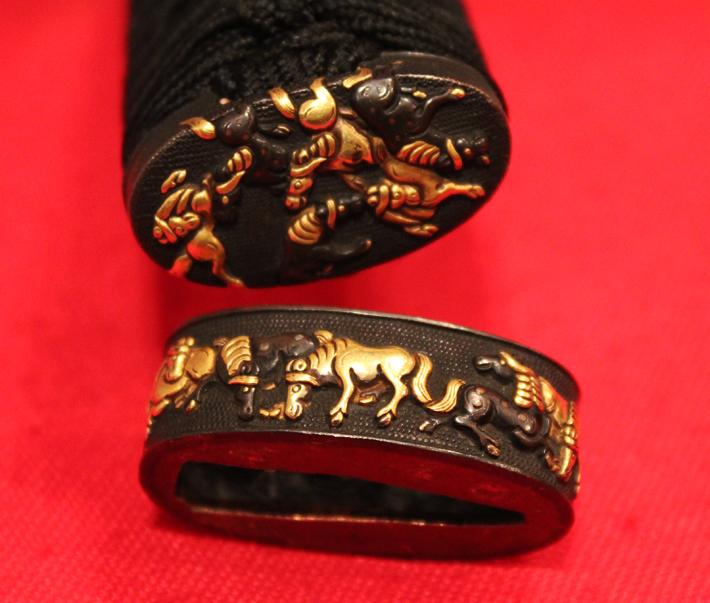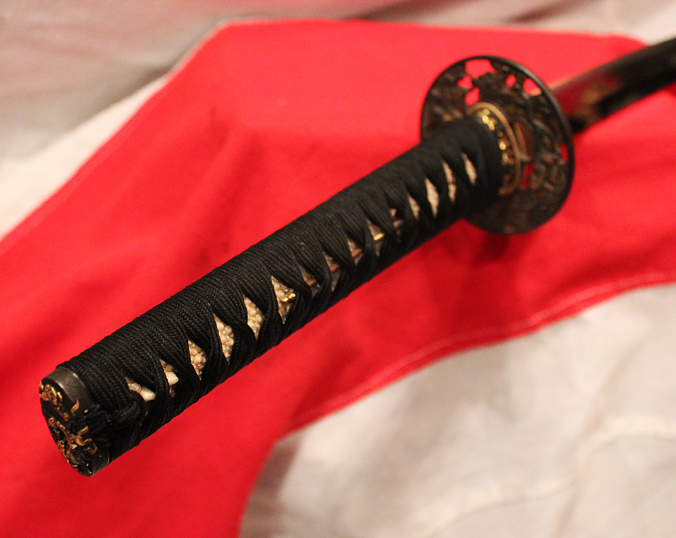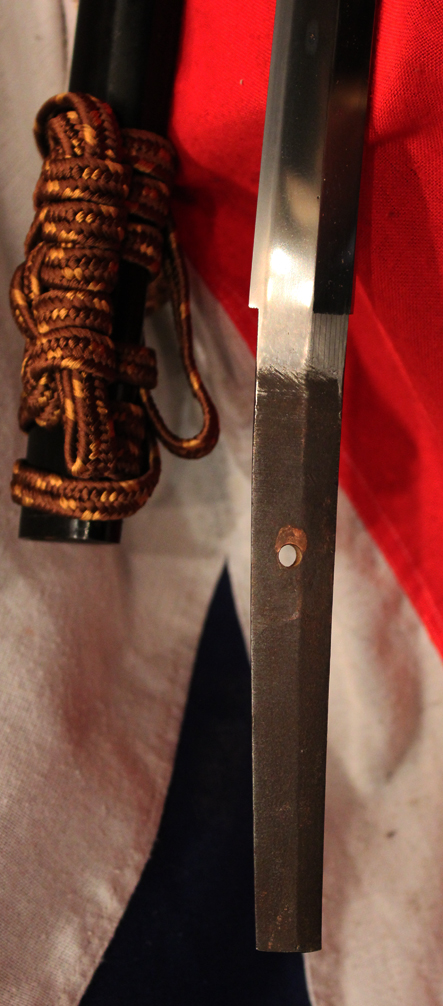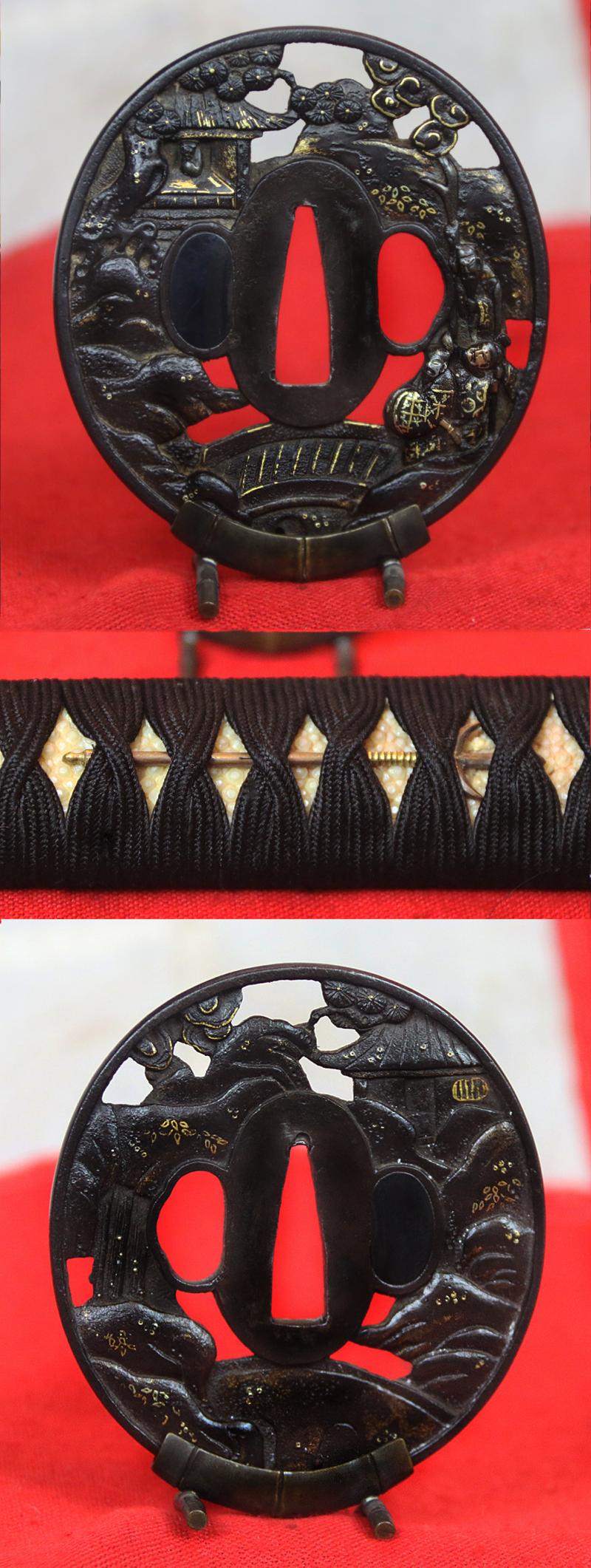A Superlative and Beautiful Koto Katana Circa 1500, A Museum Quality Ancient Sword, Sengoku Era, with Stunning Original, Edo Period, Soten School Mounts of Shakudo & Gold, “Koushi Seiyu Zu” Tsuba
Soten school shakudo and gold fuchi kashira depicting gamboling pure gold and shakudo samurai ponies, on a nanako ground. Nanako Ji: "fish roe ground" A surface decoration produced by forming very small raised bosses by a sharply struck punch or burin called 'nanako tagane'. Shakudo is the metal most often used, but copper and gold are quite often employed. The harder metals, shibuichi, silver and iron are rarely decorated in this way. The size of the dots vary from 0.04" to 0.008" (25 to 125 and inch) and the regularity of the work is marvelous as the dots must be spaced entirely by touch. The dots are usually arranged in straight lines or in lines parallel to the edge of the piece being decorated, but sometimes in more elaborate patterns. Used on guards since the Momoyama period although the technique existed since much earlier periods. Usually done by specialist 'nanako-shi', but sometimes done by the maker of the guard himself.
Complimented with a wonderful Soten school tsuba in iron and gold, depicting sages crossing a bridge below a temple. Tsuba design in the manner of Mogarashi Nyudo Soten 藻柄子 入道宗典, a tsuba we would suitably title, Koushi Seuyu Sukashi.
Mogarashi Nyudo Soten was the son of the first Soten, who was a famous metalworker in the middle of the Edo period. He was excellent at the same type of engraving technique as his father. This Tsuba describes “Koushi Seiyu Zu” with sukashi {openwork}. It is a popular motif that has been designed since ancient times. Koushi means an honourable person, and Seiyu means to travel. It would be a longing for sages to indulge in hobbies and arts in nature, far away from the world. Each wise sage's face is clearly and minutely engraved. All the trees, clouds, rocks, the sage's clothes and the temple are all inlaid with pure gold. It is easy to appreciate its stunning beauty. It was his notable technique that if you focus on sage’s clothes pattern, you will find be able to find a traditional Japanese good-luck pattern of oblique crosses called the kikkou pattern, named after the turtle shell which represents long life. Under the traditional black silk tsuka-ito {hilt binding} ,are copper and gold jumonji yari {trident spear form} samurai polearms, over same-gawa {giant rayskin}
A superb ancient samurai sword that would grace any fine collection of oriental art or compliment any residence albeit traditional or contemporary decorated. It is shown with a fresh gold and brown sageo sword saya wrap
The Sengoku period was initiated by the Ōnin War in 1467 which collapsed the feudal system of Japan under the Ashikaga Shogunate. The Sengoku period was named by Japanese historians after the similar but otherwise unrelated Warring States period of China. The era is beautifully depicted in Akira Kurowsawa’s films called Jidaigeki. The Sengoku Period (1467-1568 CE) was a lawless century-long era characterized by rising political instability, turmoil, and warlordism in Japan. During this period, field armies and soldiers rapidly rose in number, reaching tens of thousands of warriors. Many castles in Japan were built during the Sengoku Period as regional leaders and aristocrats alike competed for power and strong regional influence to win the favours of the higher-class Japanese at the time. Kurosawa’s film depiction of Macbeth, Throne of Blood, is set in this era of Japan’s feudal period. Original title 蜘蛛巣城, Kumonosu-jō, lit. 'The Castle of Spider's Web'
This then led to the creation of a more complex system within the military, the armoured infantry known as the ashigaru. Initiated by the collapse of the country’s feudal system during the 1467 Onin War, rival warlords or daimyō, continued to struggle to gain control of Japan until its reunification under Japan’s three “Great Unifiers” –– Nagoya Nobunaga, Hideyoshi, and Ieyasu Tokugawa –– thus, bringing the war-stricken era to an end in the siege of Osaka
The classical beauty of samurai swords is remarkable, in that there is barely any kind of decor that is not improved with their addition. With fine Soten mounts of pure gold ponies grazing in a meadow and an iron and gold inlaid Soten sukashi tsuba depicting mandarin and companion crossing a bridge with a warrior guard armed with a polearm. Blade with a fine sugaha straight hamon in original Edo polish. Fine black silk wrap covering menuki of long. Fine black Edo lacquer saya with sageo of gold and brown woven silk. Of all the weapons that man has developed since our earliest days, few evoke such fascination as the samurai sword of Japan. To many of us in the, the movie image of the samurai in his fantastic armour, galloping into battle on his horse, his colourful personal flag, or sashimono, whipping in the wind on his back, has become the very symbol of Japan, the Empire of the Rising Sun. And, truly, to the samurai of real life, nothing embodied his warrior’s code of Bushido more than his sword, considered inseparable from his soul.
Indeed, a sword was considered such a crucial part of a samurai's life that when a young samurai was about to be born, a sword was brought into the bedchamber during the delivery. When the time came for an old samurai to die and cross over into the White Jade Pavilion of the Afterlife, his honoured sword was placed by his side. Even after death, a daimyo, or nobleman, believed he could count on his samurai who had followed him into the next world to use their keen blades to guard him against any demons, just as they had wielded their trusty weapons to defend him against flesh-and-blood enemies in this life. In a samurai family the swords were so revered that they were passed down from generation to generation, from father to son. If the hilt or scabbard wore out or broke, new ones would be fashioned for the all-important blade. The hilt, the tsuba (hand guard), and the scabbard themselves were often great art objects, with fittings sometimes of gold or silver. The hilt and scabbard were created from the finest hand crafted materials by the greatest artisans that have ever lived. Often, too, they told a story from Japanese myths. Magnificent specimens of Japanese swords can be seen today in the Tokugawa Art Museum’s collection in Nagoya, Japan. Overall 37.5 inches long in saya
Code: 19377
9995.00 GBP




